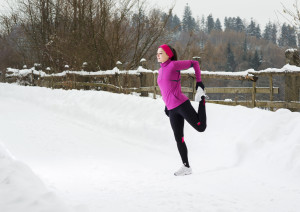
With 5K and marathon-training season in full gear, runners should reevaluate their cool-weather regimens.
To avoid injury and improve performance, it’s important to understand the best ways to prepare for outdoor training during relatively cold months.
Clothes, shoes and diet are all important factors, but it can also help tremendously to warm up properly before training or competition. In cooler weather, it’s best to perform dynamic stretching prior to a race, not only to improve core temperature but also to keep muscles loose and “fired up.”
Dynamic stretching
Dynamic stretches take a joint through a functional range of motion that gradually increases with repetitive movement.
A lunge, for instance, can be a dynamic stretch if you hold it for a certain period of time, gradually improving range of motion with each repetition.
Dynamic stretching is often confused with ballistic stretching, which is forceful, repetitive movement beyond normal range of motion. The problem with ballistic stretching is it doesn’t allow the muscle to relax or adjust to its new range.
The benefits of dynamic stretching:
- It relaxes muscle during brief and intense movement, allowing for elongation of the muscle without straining.
- It improves peak force of muscle.
- It improves the rate of force during muscle contraction.
- It improves core temperature and muscle temperature.
- It reduces the chance of injury.
If you’re performing a dynamic movement such as running or jumping, it makes sense to perform dynamic stretches beforehand.
Static stretching
Static stretching is the most common way to stretch. Focusing on a particular muscle or joint, an athlete will maintain a position beyond the normal range for an extended period of time.
Static stretching has been thought to reduce injury and improve performance, although current research indicates this method may actually slow the muscle and inhibit excitation of the muscle during voluntary contraction (also known as explosive movement).
Furthermore, some studies have shown that static stretching does not prevent injury.
Still, static stretching can improve flexibility and overall length and tone of a muscle. It makes sense, then, to perform static stretches after an activity—during the “cool-down phase”—although these types of stretches can also be effective if they’re done an hour before competition or training.
Some athletes will jog first to raise their core temperature, making it easier to stretch their muscles.
Dynamic stretches, meanwhile, should be performed about 30 minutes before competition. Maintain core temperature by jogging for several minutes and then perform a series of dynamic stretches.
Just remember not to become fatigued—your goal is to loosen up the muscles, and also get them “fired up” at the same time.
Dynamic stretches may include lunge walks; side lunge walks; mountain climbers; running butt kicks; walking with high knees; power skipping; or, lying down, perform alternating leg lifts keeping your knees straight.
Again, don’t wear yourself down. You should choose four to five exercises to perform and do one to two sets, with five to eight repetitions each.
 /a>
/a>
 /a>
/a>
 /a>
/a>